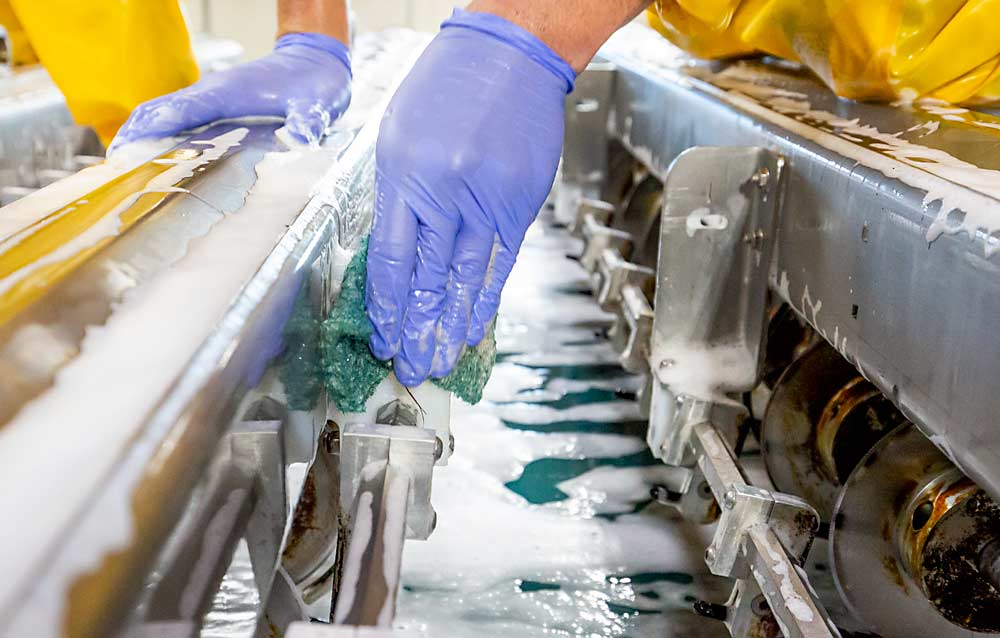
Clean quickly, clean thoroughly and consider including peracetic acid in your chemical sanitation quiver.
A Washington State University microbiologist has determined the acid, often called PAA, works better than other sanitizers at reducing Listeria monocytogenes, commonly referred to as listeria, on packing house surfaces.
What’s more, PAA seems to be less sensitive to how much dirt is on a surface and the maturity of biofilm, the thin layer of bacteria that adheres to a surface and serves as a contamination source.

Those were among the conclusions Meijun Zhu shared in a paper published in October in the journal Frontiers in Microbiology and with growers in May at the 2018 Postharvest Academy in Cle Elum, Washington.
In her Pullman laboratory, equipped with a miniature packing line, Zhu has been tinkering with how best to use the variety of available sanitizers — to inform decisions in apple, pear and cherry packing facilities trying to comply with the Food Safety Modernization Act and, more importantly, prevent the spread of pathogens, such as listeria.
She has compared the efficacy of the chemicals, their exposure times, their concentrations and how well they work on different biofilm maturity levels and on intentionally soiled surfaces.
Her work is ongoing, but she has reached several instructive conclusions so far.
But first, the warning you can’t repeat too often: Clean first. Only then, sanitize. Trying to sanitize a dirty surface is a “waste of money,” said Ines Hanrahan, director of the Washington Tree Fruit Research Commission and one of Zhu’s research collaborators on the project. The research commission is funding Zhu’s work.
“Before you are attempting to sanitize anything, you have to clean,” Hanrahan said.
In fact, Zhu’s research result proves exactly that. All the sanitizing compounds — even PAA — she compared lost efficacy when used on surfaces intentionally tainted with organic matter such as apple juice or milk. PAA just showed less reduction in efficacy.
Here are a few other highlights of her findings so far.
—In the spray bar sanitizer intervention, PAA at a concentration of 80 parts per million for two minutes resulted in a 1.7 log reduction of listeria — or 50 times less — on a fresh apple surface, compared to 1.0 log reduction by chlorine-based sanitizers, including chlorine, neutral electrolyzed water and mineral oxychloride or JC9459, at 100 parts per million free available chlorine. Researchers track pathogens on a logarithmic scale. A single log reduction is a 10-fold, or 90 percent, reduction of bacteria population.
—Jump on biofilm early. The older it gets, the harder it is to clean no matter what sanitizer you use.
—Though biofilm age and organic matter diminishes the efficacy of all sanitizers, they have less effect on PAA than others.
—Water hardness and pH don’t much change the efficacy of PAA.
The sanitizers she compared in her biofilm study are PAA, chlorine, chlorine dioxide, ozonated water and quaternary ammonium compounds. Quaternary ammonium compounds, or QACs, are the most commonly used in surface sanitation, Zhu said. Chlorine-based sanitizers are the least expensive. PAA is more expensive than others and the only one that qualifies to work with an organic regimen.
All that said, Zhu and her colleagues are not ready to make any specific recommendations about what chemicals to choose, Hanrahan said.
For one thing, Zhu’s work will continue for one more year. Her Frontiers paper focused on the results of experiments on polystyrene surfaces used in her laboratory. She plans to continue the trials on stainless steel, plastic and other surfaces more commonly found in fruit packing warehouses and optimize conditions to achieve the maximum reduction, she said.
Currently, packing houses use a variety of sanitizers, including PAA. They all serve different purposes and each facility likes to do things a little differently. Zhu’s project is more about fine-tuning all those tools, not selecting the best one, Hanrahan said.
“We want to figure out how to best use those things,” she said. •
—by Ross Courtney
Related:
— Is it really clean? Aggressive cleaning makes big difference
— The clean team






Why can’t we just sanitize with steam and hot water?
Decent question and it sounds like you’re onto something after checking with the researcher. Here is what she said:
“1. Steam and hot water are not commonly used in the tree fruit industry at present.
2. The compatibility of steam and hot water depends on the type of surface.
3. More studies will be conducted in this direction.”